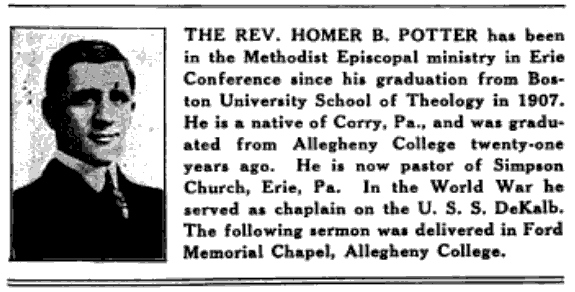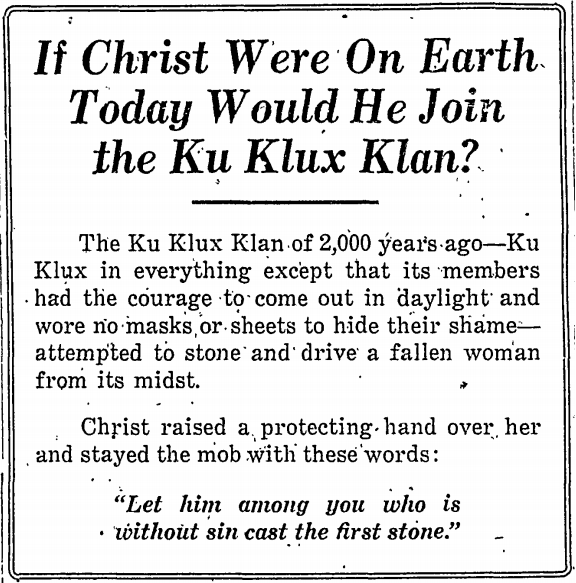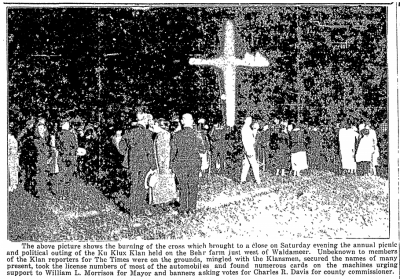Thinly Shrouded Racism
The Ku Klux Klan and white supremacy in Erie
The Ku Klux Klan is the most infamous of the many white supremacist groups that have existed throughout the United States. This is in part due to their portrayal in Hollywood movies, from Mississippi Burning to the more recent BlacKkKlansman, but also due to their secrecy, their regalia, and their campaigns of terror.
In the 1920s, a second wave of the Ku Klux Klan was growing in numbers and power throughout the country. This was partially due to the popularity of D.W. Griffith's 1915 film The Birth of a Nation, which glorified and romanticized the Klan, but also their new and more modern system of recruitment. At their peak, this second Klan claimed to have somewhere between 4 to 5 million members at a time when the U.S. population was around 100 million.
Despite the common perception that the Klan was a problem historically plaguing only southern states, this second Klan tightened its grip in northern states as well, expanding deeply throughout Pennsylvania. By 1923, the Klan was making news daily in the state, such as in Wilkinsburg, when thousands of Klansmen descended on the town, conducting a parade that blocked traffic for at least an hour while they also set off "red lights, fireworks and bombs," before inducting 500 news members and setting fire to a 50-foot-tall cross.
During this time, the Erie branch of the Ku Klux Klan had entrenched itself in the community, involving itself in local politics, co-opting local churches into their cause, and making it known that vigilantism was a tactic they weren't afraid to employ.
In February of 1923, Dr. Rev. Homer B. Potter, who pastored the Simpson Methodist Episcopal Church in Erie, gave a sermon to 300 members of the local Klan. He preached that he did not agree with all the Klan's platform, but that Erie's Klansmen were "law-abiding citizens who will not act as bigots or law-breakers." He declared that the Klan was necessary for Erie.
 During a 1923 sermon, Homer B. Potter, a pastor at Simpson Methodist Episcopal Church, declared that the Ku Klux Klan was necessary for Erie The Christian Advocate/Newsbank
During a 1923 sermon, Homer B. Potter, a pastor at Simpson Methodist Episcopal Church, declared that the Ku Klux Klan was necessary for Erie The Christian Advocate/Newsbank
"[T]his Erie Klan has done some things for which the church and law-abiding citizens may well be thankful," Potter said. He pointed out the speakeasies around Erie. If the city wouldn't shut them down, then the Klan would. "And so long as they continue to do it, they are what Erie needs."
During another evening service, Potter preached on "Americanizing Americans." A newspaper advertisement noted the Ku Klux Klan as "guests of the evening." In April, the Lawrence Park Methodist Episcopal Church held a service where Rev. Harvey H. Bair gave a sermon titled "The Patriotism of Jesus." The local Klan, again, were advertised as "guests of the church." The Central Presbyterian Church, recognizing the increasing grip of the Klan in Erie, advertised a "present-day and popular theme" to be discussed the following Sunday: "Shall I join the Ku Klux Klan?"
Meanwhile, Rev. W. D. Dempster, a Presbyterian minister from Crafton, Pa., met with the Erie Ministerial Association to discuss if they should accept Klan contributions. Dempster spoke admirably of the KKK, noting that they were an "American Protestant organization" who did "missions of charity." They would only "maintain law and order and act if city and county officials are negligent," Dempster reasoned.
Erie was about to witness this maintenance of "law and order."
In the early months of Prohibition, a 25-year-old black Erie woman named Ruby Scott had been arrested for selling whiskey to undercover federal agents at her German Street home, which also served as a boarding house. She was fined $500. In February of 1923, she was arrested again, this time on charges of "being the proprietress of a disorderly house." On the night of April 20, she had returned to her home just before midnight when hooded Klansmen appeared.
They doused a cross in petroleum and ignited it in her front yard. Scott, not initially realizing it was the Klan, went for her revolver but decided against confronting them. They graffitied her front door with "KKK" and left her a warning letter, but fled before the police arrived.
"The Kluxers have just paid your disorderly house its first visit, to warn you and the rest of your kind to close up and get out," the letter read. "You have defied the laws of God, country, and city long enough. Now listen, you black violators, close your places and go. Erie does not want you."
If they returned, they warned, it would be their "second and last visit" and would "be one of greater force."
By morning, the newspaper reported she appeared frightened, but she stood her ground and refused to leave, while publicly pointing out all of the letter's spelling errors. The district attorney promised charges if he could "secure sufficient evidence." He did not.
As the Klan's numbers grew in Erie, so did their confidence. That August, the Erie Daily Times ran a story titled "Koo Koo Klaners Parade in Fords." After a late-night meeting at their headquarters at 818 State St., plainclothes Klansmen went "parading up and down State Street in their automobiles (mostly Fords)."
"Talk about noise. These night owls who paid ten dollars [in dues] to learn some secret stuff, blew their horns for twenty minutes," the Times reported sarcastically. "They disturbed the peace."
 During the 1920s, the merits of Ku Klux Klan membership was legitimately debated in some white churches — this church bulletin condemns the group's overly glorified self-righteousness. Erie Daily Times/Newbank
During the 1920s, the merits of Ku Klux Klan membership was legitimately debated in some white churches — this church bulletin condemns the group's overly glorified self-righteousness. Erie Daily Times/Newbank
Later that month, the Erie Klan held their first of what was to be an annual picnic and "joint political-social outing" on Behr Farm across the road from Calvary Cemetery on West Lake Road. It was an election year and the local Klan was working out a list of endorsements. This included the Erie mayoral primary, in which they were planning to endorse William L. Morrison over the Republican favorite, Joe Williams.
What the organizers did not realize was that, despite having guards around the perimeter, Times reporters had infiltrated the event undercover. They estimated a total of 2,000 men, women, and children attended. The reporters "mingled with the Klansmen, secured the names of many present, [and] took the license numbers of most of the automobiles..."
Throughout the day, Klan leadership debated endorsements. Some conversations were heated. To close the evening, the Klan then had their "customary display of 'the fiery cross.'" It stood 30 feet and "lighted up the sky ... easily discernible for a mile or more."
By this point in 1923, Klan activities were dominating news coverage in the Times.
"We suspect that a good many fellows join the Ku Klux Klan simply to have a new excuse to hand the wife anytime they happen to be out all night," one resident joked in a letter to the editor. "Too many wives were getting wise to the 'sick friend' alibi."
"We shall not join the Klan while they continue to charge ten dollars for ordinary cotton nighties," quipped a columnist.
Meanwhile, just south of downtown Pittsburgh, approximately 25,000 Klansmen congregated. During one march, a group of Klan resistors (referred to in the paper as "antis") blocked them. Violence ensued and a robed Klansman was killed and "scores of others" were injured. The Klan offered up a reward of $2,500 for the killer and they condemned "the action of the mob" which had a "sense of anarchy."
On Sept. 4, the Times reported the Klan's official endorsement of William Morrison for mayor. The meeting had taken place at their State Street headquarters and of the 318 Klan members present to vote, 315 chose Morrison.
The Erie Daily Times was not attempting to hide their bias. They were clearly aiming to take on the Klan, as well as keep the Klan's endorsement of Morrison fresh on everybody's minds. The Erie Dispatch Herald, Erie's other prominent paper which preferred Morrison, condemned the Times for continuously linking his campaign to the Klan.
"The next mayor of Erie will have a lot of big problems to meet, problems that must be met wisely if the best interests of the city are to be served," Times editors wrote. "And they are not the sort of problems the additional state police or the Ku Klux Klan can help him solve."
In another editorial, they implied that the Ku Klux Klan was "a menace to the pursuit of liberty guaranteed by the constitution" and that the "organization is declared to encourage race prejudice and religious bigotry instead of promoting fellowship and good will." One published letter referred to the KKK as "illiterates" and "night shirted cobras."
Each time the Times published a story about the upcoming mayoral election, they reminded readers of Morrison's Klan endorsement. By Sept. 6, Joe Williams had 5 to 1 odds over Morrison. This agitated local Klan leaders.
Early in the morning on Sept. 8, a fire was reported at the Klan's State Street headquarters. Fire department officials were able to keep it from burning to the ground, but it caused thousands of dollars of damages, including to the Woolworth's below and apartments above them. They believed the blaze was started by a Klansman's discarded cigarette, as the Klan held a meeting throughout the night after an evening of burning crosses outside of city limits.
Discovered during the morning fire was a business directory. Times reporters on the scene wrote down the more the 100 local businesses that appeared to have dealt in some way with the Erie Klan. Some businesses, it appeared, offered perks to Klan members. The Times published a list of these businesses which included grocers, jewelers, builders, dentists, chiropractors, plumbers, barbers, insurance agencies, banks, and more.
In the following days, many of these business owners denied being in the KKK or having any connection to or business dealings with them. "[I] am not in sympathy with the organization and did not know that our business card was in the rooms of the Klan," George Epp of Epp Furniture Company released in a statement.
"We are not knights of the Ku Klux Klan," another grocer advertised. "We offer $50.00 to anyone if this is not true."
Dozens of other public denials were made over the following days.
Perhaps emboldened by the newspaper's escalation, the downfall of Morrison's campaign, and heightened emotions over the fire, Rev. Ethelbert D. Hulse escalated the Klan's feud with the Times on Sept. 10. Hulse, who was a preacher at the Tenth Street Methodist Church and the Erie County Jail, was also a prominent member of the Klan. With 60 robed Klansmen hooded and in the front rows of his service, he attacked the publisher and editor of the Times as "waging a battle against the Ku Klux Klan" and claimed that they were not "one hundred percent American" like the Klan.
"He was greatly perturbed and told his audience they should not become discouraged," the Time reported. Hulse seethed that Erie politics were "of the skunk variety," then revealed to the congregation that the Klansmen in attendance were concealing guns and that an unnamed state official had approved this violation of the law, which was greeted with thundering applause.
In response to this escalation, the Erie Daily Times published 21 license plate numbers of vehicles outside of the church. This included a handful of prominent members of the Erie community.
After Morrison lost the primary to Williams, coverage of the local Klan dwindled. The momentum that the Klan had built over the previous year seemed to stall as well. On Dec. 31, a Ku Klux Klan leader, who was a volunteer state policeman and attempting to obtain a federal Prohibition job, had his home on Stafford Avenue vandalized while he and his wife were at a dance: furniture was smashed, lights were torn from the walls, fixtures were shattered, and water was left running in a bathtub, filling the entire home with ankle-deep water.
"Police declared it was one of the most complete jobs they had ever seen," the Erie Daily Times reported.
By 1925, total membership in the local Klan had declined to around 700. Even if membership had declined though, the ideologies that permitted its rise in the first place would continue to persist. White supremacy ideologies, in fact, persisted in Erie in many forms throughout the following century — although most white supremacists traded in their robes for suits, a deliberate tactic meant to legitimize themselves as well as distance themselves from the Klan.
On Nov. 28, 1998, the Klan visited Erie once again, a rally planned for outside the Erie County Courthouse, organized by a woman out of Allegheny County.
"We are there to stand up for white rights," Kathryn Negley Hedrick, who went by the pseudonym Kay Ryan as the branch's leader, said two days prior. This time though, 75 years after the Klan was increasing its grip on the city of Erie, only 25 Klansmen were present — and they were met with fierce resistance.
"The Klan were met by 400 furious spectators, who simply couldn't resist unloading their verbal outrage at these hooded fools," the Erie Times-News editors wrote. "Thirty-two blocks to the south [at Mercyhurst], 500 people gathered for a 'Unity in Our Community' rally, set up to offer the community a celebration to the power of diversity."
"The people here, assembling like this, to stand together to oppose hatred, it tells me that Erie is moving forward in teaching its young people," an 80-year-old Cornelius J. Smith told journalist Ed Palattella at the time, after recalling to him a time in Erie when he and friends who had purchased tickets to a skating party were not permitted in because they were black.
"There has been a great change in Erie," Smith added.
Erie, like the rest of the United States, has a long way to go in confronting and accepting its past. White supremacist ideologies that once made the Ku Klux Klan both popular and powerful still permeate every part of our society. If we recognize this and recognize the flaws within our society, we can continue to effectively rework it in a meaningful way.
Jonathan Burdick runs the historical blog Rust & Dirt. He can be reached at jburdick@eriereader.com




